Abstract
In a power system with a high proportion of renewable energy, sudden increases in wind power or photovoltaic output can lead to huge challenges, such as difficulties in accommodating excess renewable energy and imbalances between supply and demand on the grid. As an important adjustable resource on the demand side, air conditioning load is a flexible load for realizing output consumption. In this paper, a heterogeneous air conditioning load regulation strategy for renewable energy consumption is proposed. Each air conditioning load regulation quantity is obtained based on the day-ahead dispatching mode. Then, the temperature setting value, rated power, and duty cycle are selected as the indexes. The load regulation sequence is obtained by the entropy weight method. Finally, the load regulation time of each air conditioning load is obtained based on the constraint of the quantity of loads during the possible adjustment time. The simulation analysis shows that the temperature regulation strategy presented in this paper can effectively reduce the power fluctuations of air conditioning loads, while ensuring that users with lower temperature settings are selected in the adjustment process.
1. Introduction
With increasing global concern for the environment, renewable energy technologies, such as wind and solar power, are set to become the primary energy sources for the future due to their environmentally friendly and sustainable characteristics. Despite the significant advancements made in renewable energy power generation technologies, their shortcomings, such as unpredictability, volatility, and intermittent production, have also been exposed [1]. To enhance the operational flexibility of a power grid and prevent scenarios where wind power and photovoltaic output are abandoned, a significant number of adjustable resources have been made from the demand side [2]. To enhance the renewable energy consumption capability of a power grid, thermostatically controlled loads, such as air conditioners, heat pumps, electric water heaters, and refrigerators, are utilized as indispensable user-side adjustable resources to address the challenge of renewable energy output fluctuations [3].
Scholars have carried out extensive research on the regulation and control of thermostatically controlled load participation in renewable energy consumption. In [4], a control method considering the state change of a thermostatically controlled load switch was proposed so that a thermostatically controlled load could be adjusted continuously when it was absorbed. In [5], a maximum power tracking control was used to control thermostatically controlled loads in real time, which realized the consumption of home photovoltaic output and promoted the development of home distributed power generation technology. Reference [6] took into account the temperature setting value and adjustment priority of thermostatically controlled loads and aggregated thermostatically controlled loads to participate in wind power consumption. Reference [7] proposed a novel direct load control mechanism based on technical constraints. Considering the running state of electric water heaters, the dynamic model of an electric water heater based on a finite-state machine was constructed in [8], which could sensitively track the output curve of renewable energy. In [9], a hierarchical distributed control strategy was proposed, which could effectively suppress the fluctuation of renewable energy by using an electric heat pump. With respect to air conditioning load, based on a mathematical model and control logic of air conditioning loads, a variable-frequency air conditioning operation control method considering time constraint was proposed in [10], which had an efficient consumption effect. In [11], a real-time response potential estimation method for air conditioning loads was proposed to guide the fluctuation of photovoltaic power generation in the balance of air conditioning loads. In [12,13], an energy storage model was used to express the ability to regulate aggregated air conditioning loads during participation in the consumption of renewable energy in a power grid. The aforementioned research has focused on a long-term scenario for absorbing renewable energy, where a high proportion of renewable energy is being accessed. However, the short-term increase in renewable energy output caused by sudden weather changes is an important scenario which needs to be considered. Such an increase has the factors of randomness and rapid occurrence, which is an emerging problem limiting the development of renewable energy technologies. One idea to tackle this issue is to use thermostatically controlled loads to participate in the consumption process.
The equivalent thermal parameter (ETP) model is a frequently used model to describe air conditioning load [14,15,16]. There are various control methods available for managing air conditioning loads. Direct load control (DLC) is the most widely used approach, which includes switching control, periodic suspension control, and temperature control. Switching control and periodic suspension control can potentially neglect the comfort of users. Temperature control [17] can more accurately reflect the changes that users experience. As a result, temperature control is widely applied. In [18], a density clustering control strategy based on load temperature was proposed to control the load group with the temperature setting value as the response signal. On the basis of temperature control, an hourly scheduling model to control for temperature difference was established in [19]. The parameters of different users’ air conditioners are different, making the collection of all users’ air conditioners a heterogeneous system, which can lead to significant fluctuations of aggregated power [20]. The method for previous temperature control modes supposed that the parameter of different user was same so that the best adjustment effect cannot be achieved when considering individual differences among users. In the short-term control services of a power grid, this will lead to drastic fluctuations of aggregated power when the current temperature control method used for homogeneous air conditioning loads is used for heterogeneous air conditioning loads. Basically, this issue can be avoided by optimizing time and sequence of air conditioning adjustment to maintain the grid’s safety.
In this paper, a heterogeneous air conditioning load regulation strategy is proposed for renewable energy consumption. This paper not only determines the amount of temperature regulation for each air condition but also obtains the adjustable time for each load. The proposed adjustable strategy reduces the fluctuation of aggregated power during the adjustment process by increasing the adjustment time period. The main contributions of this paper are as follows:
- (1)
- The set temperature, rated power, and duty cycle are selected as the indexes to evaluate the sequence of air conditioning loads. The optimized regulation sequence can make the adjustment behavior evenly distributed among users as a whole and ensure the priority adjustment for users with a low temperature setting value.
- (2)
- Based on the potential adjustment time, the regulation sequence, and the quantity constraints of available air conditioning loads during the adjustment process, the adjustable time of each air condition can be obtained. The optimized regulation time can reduce load fluctuations caused by regulation behavior.
2. Aggregated Power Model of Air Conditioning Loads
The equivalent thermal parameter model is commonly used to describe a single air conditioning load. According to References [21,22,23], the first-order equivalent thermal parameter model shown in Figure 1 is selected to analysis the aggregated power of air conditioning loads.

Figure 1.
First-order ETP model of a single air conditioning load.
The expression for indoor temperature can be simplified as follows:
When the air conditioning load is turned off,
When the air conditioning load is turned on,
where
Here, Ti and To represent the indoor temperature and outdoor temperature, respectively; R is the equivalent thermal resistance; Ca is the indoor equivalent heat capacity; Q represents the heat exchange capacity between the air conditioning load and the room; P represents the electric power of the air conditioning load; and η represents the energy efficiency ratio.
When the outdoor temperature remains constant, the indoor temperature changes as shown in Figure 2. Based on Formulas (1) and (2), the load duty cycle D of the air condition can be calculated based on Formula (3), where, is the temperature dead zone. The load duty cycle D is an important parameter which is employed to determine the duration of a load in the on state.
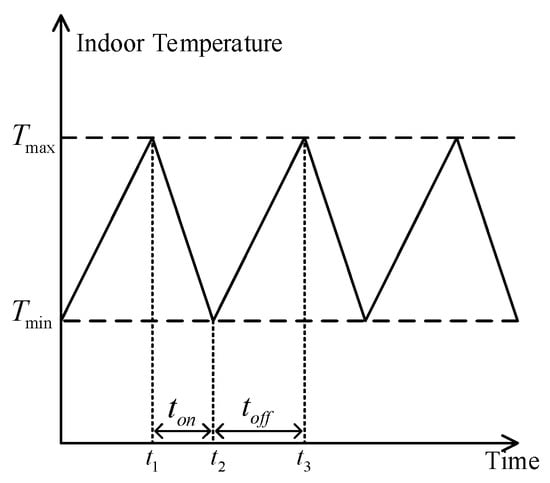
Figure 2.
The change in indoor temperature.
The aggregated power Pagg of N air conditioning loads can be expressed as follows:
where, Pi represents the power of a single air conditioning load, and s(i) represents the on/off state. When the indoor temperature surpasses the permissible upper limit, the air conditioning load is switched on, as denoted by s(i) = 1. Likewise, if the temperature falls below the minimum permissible threshold, the load is switched off, as denoted by s(i) = 0. Formula (4) demonstrates that the total power of air conditioning loads is significantly influenced by the quantity of air conditioning loads that are currently activated.
3. The Regulation Framework of Air Conditioning Loads
A load aggregator is employed to aggregate air conditioning loads and offer renewable energy consumption services to the power grid. Figure 3 shows the framework for regulating air conditioning loads that participate in the renewable energy consumption of a power grid.
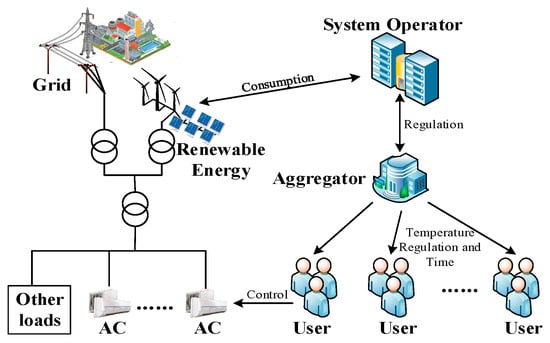
Figure 3.
The framework for regulating air conditioning loads.
Firstly, based on short-term output prediction, the renewable energy generator determines the sudden increase in output that is deviating from the production plan. Therefore, it can determine the amount of consumption needed and report it to the system operator. The system operator will then transmit the necessary regulation information to the load aggregator.
Then, after receiving the regulation quantity from the system operator, the load aggregator utilizes the parameter characteristics of the air conditioning loads in its jurisdiction to determine the temperature regulation amount and regulation time for each user’s air conditioning load. The aggregator then shares this information with the users who will participate in the regulation.
Finally, in order to absorb the sudden increases in renewable energy output, the temperature setting value of each air conditioning load is adjusted during each user’s adjustable time based on the temperature regulation strategy.
4. Temperature Regulation Strategy Considering the Load Timing Selection of Heterogeneous Air Conditioning Loads
4.1. The Process of Temperature Regulation Strategy for Heterogeneous Air Conditioning Loads
According to the regulation objective from the system operator, the load aggregator utilizes the day-ahead dispatching mode [24] to forecast the required temperature regulation of air conditioning loads. Then, the initial set temperature, rated electric power, and duty cycle are used as the air conditioning load evaluation indexes, and the entropy weight method is used to determine the air conditioning load regulation sequence. Finally, considering the on/off state transformation of air conditioning loads and the load opening quantity constraint per time, the adjustable time of each air conditioning load is determined. The flow chart of temperature regulation strategy is shown in Figure 4.
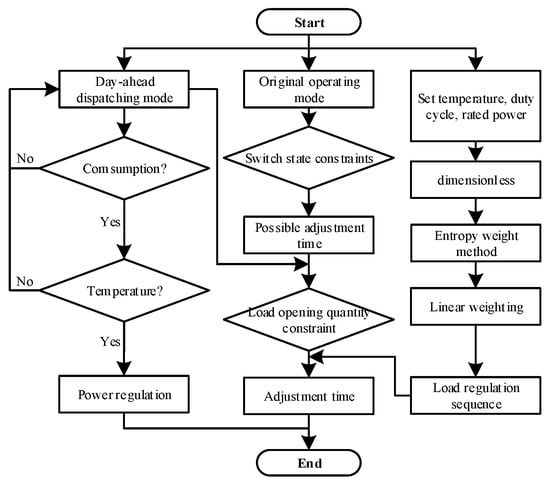
Figure 4.
The flow chart of temperature regulation.
4.2. Estimation of Temperature Regulation Using the Day-Ahead Dispatching Mode
The load aggregator needs to determine the temperature regulation quantity according to the parameter characteristics of the air conditioning loads under its jurisdiction. Due to the heterogeneity of air conditioning loads and the difference in user temperature preference, the temperature regulation amount of each air conditioning load should also remain diverse when participating in the regulation. Based on the day-ahead dispatching mode, the optimization objective is that the root-mean-square error (RMSE) between the air conditioning load aggregated power curve and the consumption target curve is the smallest, and it can be expressed as follows:
where, T1 and T2 represent the start time and the end time during the adjustment process, respectively. Additionally, ΔT indicates the length of the adjustable period. Pagg_day-ahead,t represents the aggregated power of air conditioning loads at t time in the day-ahead dispatching mode. Pagg,t represents the aggregated power of air conditioning loads at t time without regulation. Pt represents the target of renewable energy consumption in the power grid at t time. The setting temperatures of air conditioning loads can be reduced from 0 °C to 3 °C in order to ensure the comfort of users.
4.3. Selection of Air Conditioning Load Regulation Sequence Based on Comprehensive Evaluation Indexes
To minimize the impact of air conditioning load regulation on the power grid, it is essential to limit the number of loads during the consumption period. Therefore, the loads that meet the regulation conditions may not all be adjusted, and it is necessary to determine the adjustment sequence of air conditioning loads. Setting temperature, rated power, and duty cycle are important parameters that determine the performance and energy consumption of air conditioning loads. Setting temperature determines the operation state of a load; rated power represents the power consumption; and duty cycle determines the duration of a load in the on state. Therefore, this paper selects the air conditioning load duty cycle, setting temperature, and rated power as the evaluation indexes for load sequence.
Due to variations in loads and individual temperature preferences, users with lower temperature settings tend to prefer cooler indoor temperatures. With an adjustable range of 3°, changes in indoor temperature will not affect a user’s comfort level. Therefore, this paper assumes that users with lower temperature settings may be more inclined to further reduce the temperature settings of their air conditioning load. Hence, the temperature setting value index that uses the temperature setting value as an indicator to evaluate the air conditioning load must be positive:
where, is the temperature setting value of load i. This paper uses the extreme method to deal with the dimensionless problem, which is expressed as follows:
where, rik is the dimensionless index value of item k of load i.
After obtaining the dimensionless load index value, the entropy weight method is employed to determine the weight of each index. The entropy weight method [25] is an objective weighting method that determines the weight of an index according to the amount of information contained in each index. The smaller the entropy of an index, the more information it provides. Additionally, it plays a significant role in the comprehensive evaluation so that the greater the weight of this index should be. The entropy weight method is simple in calculation, which makes effective use of the index data and eliminates the influence of subjective factors.
Supposing that the evaluation matrix composed of n indexes of m evaluation schemes is X = (xij)m×n, i = 1, 2, ……, m, j = 1, 2, ……, n, the standardized methodology for the indicators is as follows, where, n is number of indexes, and m is the number of air conditioners.
where, Pij represents the standardized indicator data. The standardization treatment effectively eliminates the incompatibility between different indexes. The entropy of each evaluation index is obtained based on Formula (9):
Specifically, when Pij = 0, PijlnPij = 0. Wj is the weight coefficient of each index and is calculated as follows:
The weight coefficient wj reflects the information content of a given index. The higher the entropy weight value is, the more significant the impact of the index on comprehensive decision making will be. In addition, the greater the difference among the indexes, the more intuitively and effectively it will be reflected. Using the method of linear weighting, we can obtain the comprehensive evaluation value of each user after calculating the weight of each index using Formula (11) as follows.
where, qi represents the comprehensive evaluation value for user i, and wk is the weight of the k index.
Using the aforementioned approach, we can calculate the comprehensive evaluation value for each air conditioning load and subsequently arrange them in a descending order. This sequence is the load regulation sequence and can serve as a foundation for air conditioning load regulation.
4.4. Selection of Air Conditioning Load Regulation Time Based on Turn-On Quantity Constraint
During the process of air conditioning regulation, simultaneous regulation can lead to significant fluctuations in power. To minimize the impact of cluster load regulation and ensure efficient indoor temperature conversion, a method of temperature control and regulation is established that takes into account the heterogeneity of load parameters. The schematic diagram of change in load regulation behavior is shown in Figure 5. This approach spreads out the load regulation behavior of each air conditioning unit throughout the entire regulation period. It reduces load fluctuation resulting from such regulation behavior, thereby ensuring a steady supply of power.
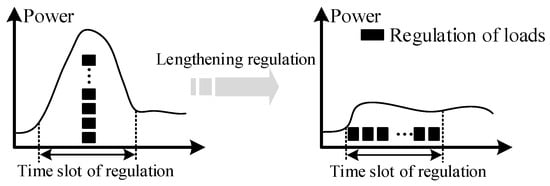
Figure 5.
A schematic diagram of change in load regulation behavior.
In order to reduce temperature fluctuations, the temperature adjustment time (start or end of regulation) is set to the on/off transition time of the air conditioner itself [17]. The possible adjusting time points of air conditioning loads are shown in the Figure 6.
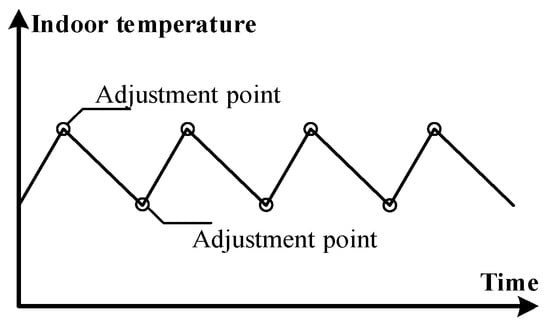
Figure 6.
The possible adjusting time points of air conditioning loads.
In order to ensure that the aggregated power of clustered air conditioning loads does not fluctuate greatly during load regulation, the opening number of air conditioning loads during load regulation is constrained. In this paper, the maximum opening capacity constraint during the load regulation is roughly estimated as follows.
where, N1 represents the maximum number of loads turned on during the offload period in the day-ahead scheduling mode. N2 represents the maximum number of loads that are converted from off to open at each time during the period of non-participation in the down consumption period. N3 represents the minimum number of loads corresponding to the amount of consumption which are turned on. Based on N1, N2 and N3, the maximum opening capacity constraint during the load regulation can be estimated as N.
Only when an air conditioning load meets the requirements of the possible adjustment time points and adjusts the number of opening constraints, will the load be adjusted for temperature.
At the end of the consumption period, a load is also constrained when it is restored. In this paper, the minimum opening constraint is roughly estimated as follows:
where, M1 represents the maximum number of loads in the cluster load opening state at each time after not participating in the lower consumption period. M2 represents the minimum number of loads that the cluster load changes from the on state to the off state at each time after the cancellation period without participating in the consumption period. M3 represents the minimum number of loads that the cluster load changes from a closed state to an open state at each time after the cancellation period is not involved in the consumption. Based on M1, M2, and M3, the minimum opening constraint can be estimated as M. The load setting temperature value is restored to the initial level only when the air conditioning load meets the possible recovery point in time requirement and adjusts the open quantity constraint.
5. Case Study
In a renewable energy access area, a load aggregator has 1000 air conditioning loads. The parameters of the air conditioning loads meet a normal distribution, as illustrated in Table 1 [26]. Furthermore, the outdoor temperature fluctuates as depicted in Figure 7 [27].

Table 1.
The distribution of air conditioning loads’ parameters.
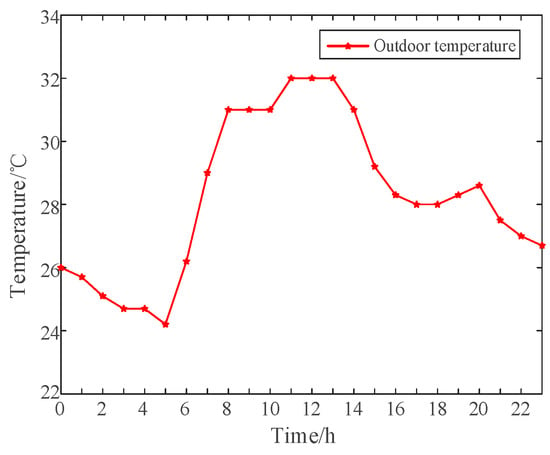
Figure 7.
The change in outdoor temperature.
5.1. Feasibility Analysis of Regulation Strategy
The regulation strategy of this paper is based on the condition that the output of renewable energy is expected to increase for approximately two hours from 8:00. This increase in output is anticipated due to an uptick in light intensity and wind speed, and it is projected to be around 200 kW. As a result, the system operator will issue a renewable energy consumption target of 200 kW to the load aggregator, which is expected to revert to its original state after the aforementioned two hours. Based on the target, the load aggregator will estimate the adjustment amount using the day-ahead dispatching mode. Figure 8 depicts the temperature regulation amount of each air conditioning load.
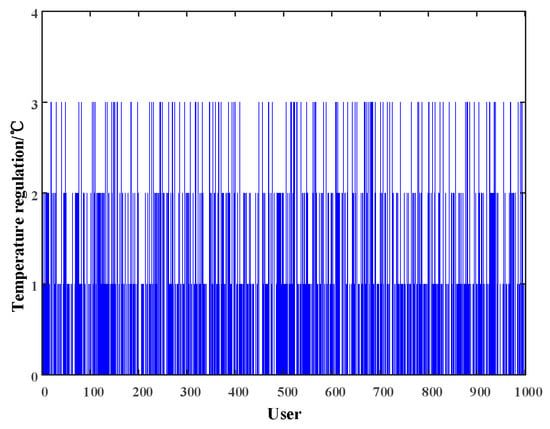
Figure 8.
Temperature regulation amount of each air conditioning load.
The load aggregator can obtain the sequence of each air conditioning load according to Section 4.3. Figure 9 illustrates the sequence of the air conditioning load regulation.
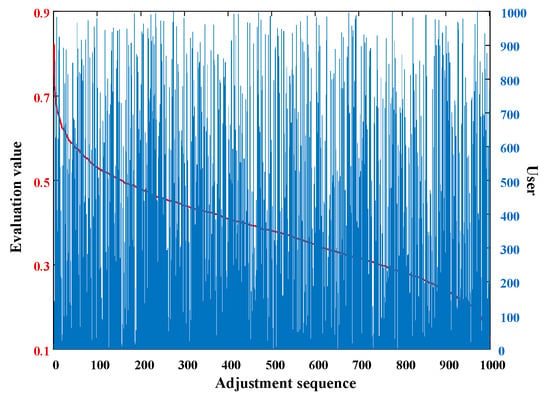
Figure 9.
Adjustment sequence of air conditioning loads.
Once the load regulation sequence is obtained, the potential time for regulating the air conditioning loads is evaluated based on each unit’s initial operational parameters. The potential adjustment times are the change point of indoor temperature increase and decrease. The change point of indoor temperature increases and decreases is obtained by the ETP model of the air conditioning loads, the load parameters and external temperatures. For example, the on/off state of the 266th air conditioning load is shown in Figure 10. It can be observed that the potential adjustment times are identified as 8:12, 8:30, 8:47, 9:05, 9:22, 9:40, and 9:57.
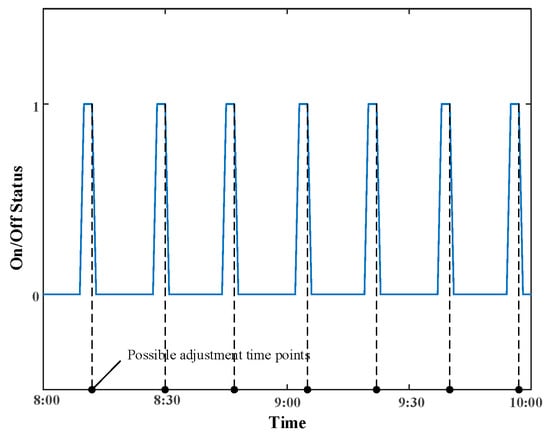
Figure 10.
The possible adjusting time of the 266th air conditioning load.
In order to reduce the load aggregation power fluctuation caused by the regulation behavior, the load opening quantity constraint is preliminarily estimated. The available quantity of air conditioning loads of the first and second hour is different in the consumption time period due to the different outdoor temperature. According to Formula (12) in the Section 4.4, the available quantity of air conditioning loads in the first and second hour should be set as 131 and 134, respectively. The adjustment time of each air conditioning load is obtained based on the load opening quantity constraint per time. The aggregated power curves of the air conditioning loads are shown in Figure 11.
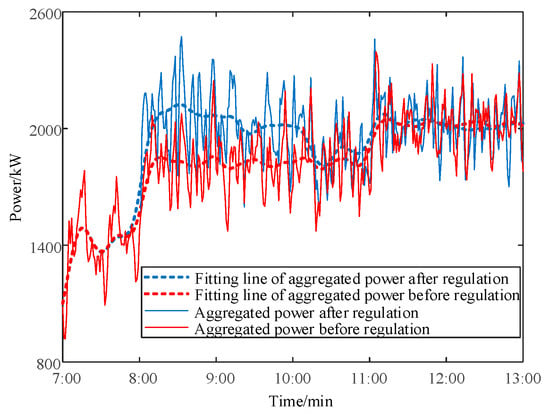
Figure 11.
The aggregated power of air conditioning loads.
Since the parameters of air conditioning loads are highly heterogeneous, the aggregated load curves can exhibit significant fluctuations. To obtain a clearer expression of the adjustment approach, the fitted curve is employed to estimate the results. In this case, 432 users have participated in the adjustment, and it shows that the control approach successfully achieves the desired consumption target.
5.2. Comparative Analysis of Different Regulation Strategies
5.2.1. Strategies with Different Regulation Time
Using the temperature regulation strategy under different adjustment time, the aggregated power change in air conditioning loads is shown in Figure 12. It can be observed that the proposed temperature adjustment strategy effectively suppresses the “peak” phenomenon of the power grid caused by the adjustment behavior of air conditioning loads, thus ensuring the safe and stable operation of the power grid. Additionally, the strategy without timing selection requires 1000 air conditioning loads, which is more than the proposed method. Therefore, under the same consumption effect, the adjustment behavior based on the method in this paper involves fewer users and has less impact on users.
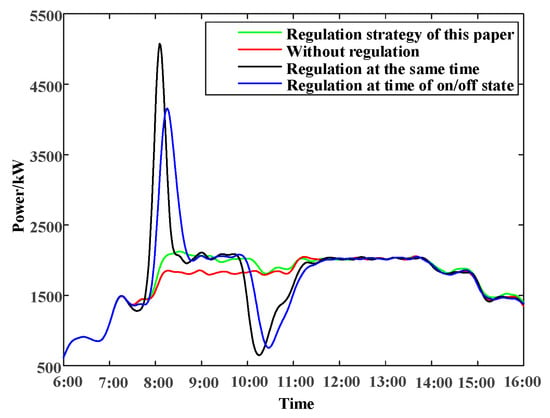
Figure 12.
The aggregated power of air conditioning loads under different regulation strategies.
5.2.2. Strategies with Different Regulation Sequences
The results with the adjustment sequence obtained based on the entropy weight method in this paper and random sequence is shown in Figure 13 (the value is one for participation in regulation and zero for non-participation in regulation). In the strategy with random sequence, it can be seen that the participation of users in regulation has an obvious stratification phenomenon, and users with an order greater than 707 will not participate in the regulation. Actually, it is not necessary for all air conditioners to participate in the adjustment process due to the load opening quantity constraint. In the random sequence, the users are selected by a random start so that the users in the order above 707 will not be involved. In the strategy with the proposed method, the users involved in the adjustment order are relatively uniform in the overall distribution. From the point of view of the single users and taking users with numbers 450–500 as an example, the users selected by the random sequence are completely randomized, and users with high temperature settings will participate in the regulation. On the contrary, high-quality users with a low temperature setting value will be given priority to participate in the adjustment by the proposed method. For example, the 457th and 458th users have the same rated power and the 457th user will be selected to participate in the adjustment according to the random sequence. Based on the adjustment sequence proposed in this paper, the 458th user with a lower temperature setting value will be selected, which is consistent with the assumption in this paper.
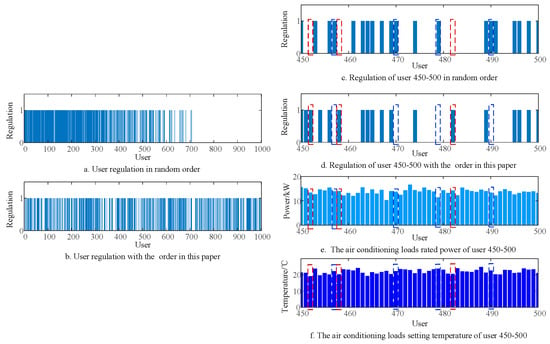
Figure 13.
Air conditioning loads’ participation in regulation under different regulation sequences.
6. Conclusions
This paper proposes a temperature adjustment strategy considering load timing selection of heterogeneous air conditioning loads. The setting temperature, rated power, and duty cycle are selected as the indexes to evaluate the sequence of air conditioning loads. Based on the potential adjustment time, the regulation sequence, and the quantity constraints of available air conditioning loads during the adjustment process, the adjustment time of each air conditioning load can be obtained. Compared with other temperature adjustment methods, the proposed method can better ensure the smooth adjustment of air conditioning loads and requires less loads to achieve the same adjustment target. In addition, using the adjustment sequence determined in this paper can ensure a relatively even distribution of participating users and prioritize high-quality users in the overall adjustment process. Furthermore, the order of the ETP model can affect its accuracy. The second order model or higher order considered the thermal inertia of wall may be studied in the further work.
Author Contributions
Methodology, S.Z. and D.F.; Software, S.Z. and D.F.; validation, L.Z.; formal analysis, J.T.; investigation, S.Z.; resources, L.Z.; data curation, S.Z.; writing-original draft preparation, D.F.; writing-review and editing, S.Z. and L.Z.; supervision, S.Z. All authors have read and agreed to the published version of the manuscript.
Funding
This research was founded by National Natural Science Foundation of China, grant number (52007126).
Data Availability Statement
Not applicable.
Acknowledgments
The authors wish to thank the editor and reviewers for their suggestions.
Conflicts of Interest
The authors declare no conflict interest.
References
- Cheng, Z.; Jia, D.; Li, Z.; Xu, S.; Zhi, C.; Wu, L. Multi-time scale energy management of microgrid considering the uncertainties in both supply and demand. Energy Rep. 2022, 8, 10372–10384. [Google Scholar] [CrossRef]
- Guo, W.; Liu, D.; Liu, M.; Zhang, H.; Wang, G.; Fan, B.; Xu, W. Demand-side resource response characteristics and peak shaving scheduling response model. Energy Rep. 2022, 8, 586–593. [Google Scholar] [CrossRef]
- Kleidaras, A.; Kiprakis, A.E.; Thompson, J.S. Human in the loop heterogeneous modelling of thermostatically controlled loads for demand side management studies. Energy 2018, 145, 754–769. [Google Scholar] [CrossRef]
- Karapetyan, A.; Khonji, M.; Chau, S.C.K.; Elbassioni, K.; Zeineldin, H.; EL-Fouly, T.H.; Al-Durra, A. A Competitive Scheduling Algorithm for Online Demand Response in Islanded Microgrids. IEEE Trans. Power Syst. 2021, 36, 3430–3440. [Google Scholar] [CrossRef]
- Burmester, D.; Rayudu, R.; Seah, W.K. Use of Maximum Power Point Tracking Signal for Instantaneous Management of Thermostatically Controlled Loads in a DC Nano grid. IEEE Trans. Smart Grid 2018, 9, 6140–6148. [Google Scholar] [CrossRef]
- Qi, Y.B.; Wang, D.; Jia, H.J. Research on demand response method of temperature Control equipment based on Normalized temperature extension margin Control Strategy. Proc. CSEE 2015, 35, 5455–5464. [Google Scholar]
- Curiel, J.A.R.; Thakur, J. A novel approach for Direct Load Control of residential air conditioners for Demand Side Management in developing regions. Energy 2022, 258, 1. [Google Scholar]
- Huang, Y.; Zhu, Y.; Mu, G.; Ding, D.; Cui, Y. Evaluation of adjustable capacity of user electric heating load based on temperature prediction. Grid Technol. 2018, 42, 2487–2493. [Google Scholar]
- Wei, W.; Wang, D.; Jia, H.; Wang, R.; Bo, B.; Qu, B. A hierarchical distributed thermostatically controlled load demand response control strategy for urban parks based on model prediction. Proc. CSEE 2016, 36, 2049–2056. [Google Scholar]
- Vanouni, M.; Lu, N. A Reward Allocation Mechanism for Thermostatically Controlled Loads Participating in Intra-Hour Ancillary Services. IEEE Trans. Smart Grid 2018, 9, 4209–4219. [Google Scholar] [CrossRef]
- Jiang, I.; Ju, P.; Wang, C.; Li, H.; Liu, J. Coordinated Control of Air-Conditioning Loads for System Frequency Regulation. IEEE Trans. Smart Grid 2021, 12, 548–560. [Google Scholar] [CrossRef]
- Song, M.; Gao, C.; Yang, J.; Yan, H.; Southeast University; Shanghai Power Company Economic Research Institute; China Electric Power Research Institute. Energy storage modeling of inverter air conditioning for output optimizing of wind generation in the electricity market. CSEE J. Power Energy Syst. 2018, 4, 305–315. [Google Scholar] [CrossRef]
- Ai, X.; Zhao, Y.; Zhou, S. Study on Virtual Energy Storage characteristics of Air conditioning load Direct load Control. Proc. CSEE 2016, 36, 1596–1603. [Google Scholar]
- Kämpf, J.H.; Robinson, D. A simplified thermal model to support analysis of urban resource flows. Energy Build. 2007, 39, 445–453. [Google Scholar] [CrossRef]
- Malhame, R.; Chong, C.-Y. Electric load model synthesis by diffusion approximation of a high-order hybrid-state stochastic system. IEEE Trans Autom. Control. 1985, 30, 854–860. [Google Scholar] [CrossRef]
- Pahwa, A.; Brice, C.W. Modeling and system identification of residential air conditioning load. IEEE Trans Power Appar. Syst. 1985, 104, 1418–1425. [Google Scholar] [CrossRef]
- Zhou, L.; Li, Y.; Gao, Z. Improvement of temperature regulation method and control strategy of polymeric air conditioning load. Proc. CSEE 2014, 34, 5579–5589. [Google Scholar]
- Sun, Y.; Chen, Y.; Li, B.; Xie, X.; Lu, Y. Heat pump load cluster control strategy based on temperature density clustering. Power Syst. Autom. 2020, 44, 46–52. [Google Scholar]
- Hao, J.; Zhang, Y.; Liu, Z.; Zhou, L.; Chen, B.; Chen, J. Game hierarchical optimal scheduling based on load temperature difference and power characteristics of air conditioning. Power Syst. Autom. 2020, 44, 70–78. [Google Scholar]
- Fan, D.; Zhang, S.; Huang, H.; Zhou, L.; Wang, Y.; Xiao, X. Three-stage day-ahead scheduling strategy for regional thermostatically controlled load aggregators. Prot. Control. Mod. Power Syst. 2023, 8, 321–331. [Google Scholar] [CrossRef]
- Mingchao, X.; Yuguan, S.; Qifang, C. Hierarchical control of thermostatically controlled loads oriented smart building. Appl. Energy 2019, 254, 113493. [Google Scholar]
- Ramanathan, B.; Vittal, V. A framework for evaluation of advanced direct load control with minimum disruption. IEEE Trans. Power Syst. 2008, 23, 1681–1688. [Google Scholar] [CrossRef]
- Xiao, H.; Zhang, M.; Zeng, L.; Wu, G.; Wu, C. Hierarchical control strategy of thermostatically controlled load considering multiple factors. Energy Build. 2012, 291, 113148. [Google Scholar] [CrossRef]
- Cheng, L.M.; Bao, Y.Q. A Day-Ahead Scheduling of Large-Scale Thermostatically Controlled Loads Model Considering Second-Order Equivalent Thermal Parameters Model. IEEE Access 2020, 8, 102321–102334. [Google Scholar] [CrossRef]
- Gui, Y.; Chen, Y. A Cache Placement Strategy Based on Entropy Weighting Method and TOPSIS in Named Data Networking. IEEE Access 2021, 9, 56240–56252. [Google Scholar] [CrossRef]
- Song, M.; Sun, W.; Wang, Y.; Shahidehpour, M.; Li, Z.; Gao, C. Hierarchical Scheduling of Aggregated TCL Flexibility for Transactive Energy in Power Systems. IEEE Trans. Smart Grid 2020, 11, 2452–2463. [Google Scholar] [CrossRef]
- Song, Y. Research on Flexible Load Optimization Control Strategy of Active Distribution Network temperature Control for Intelligent Building. Master’s Thesis, Beijing Jiaotong University, Beijing, China, 2019. [Google Scholar]
Disclaimer/Publisher’s Note: The statements, opinions and data contained in all publications are solely those of the individual author(s) and contributor(s) and not of MDPI and/or the editor(s). MDPI and/or the editor(s) disclaim responsibility for any injury to people or property resulting from any ideas, methods, instructions or products referred to in the content. |
© 2023 by the authors. Licensee MDPI, Basel, Switzerland. This article is an open access article distributed under the terms and conditions of the Creative Commons Attribution (CC BY) license (https://creativecommons.org/licenses/by/4.0/).